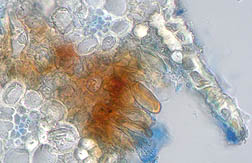This page has been archived and is being provided for reference purposes only. The page is no longer being updated, and therefore, links on the page may be invalid.
ARS Genetic Analysis Helps Spot Sugarcane Rusts
By Alfredo FloresJanuary 29, 2010
Agricultural Research Service (ARS) scientists have analyzed rust fungi from more than 160 sugarcane samples from 25 countries to provide a valuable resource for plant breeders and pathologists who are searching for genetic resistance to the deadly orange and brown rusts.
These diseases are a major concern for the sugarcane industry, so correctly diagnosing which rust is present is key, according to Lisa Castlebury, a mycologist at the ARS Systematic Mycology and Microbiology Laboratory in Beltsville, Md. Accurately distinguishing rust isolates by appearance alone is difficult, since their form and structure are very similar.
The rust known as “orange rust,” different from the standard “brown rust” that is common in U.S. sugarcane production, was found in Florida in 2007. With orange rust, a minimum of three fungicide applications are needed to still achieve acceptable yields, and those applications cost growers an estimated $40 million annually in Florida, the only U.S. cane-producing state that has this rust so far.
The study started as a simple request to Castlebury from ARS research plant pathologist Jack Comstock in Canal Point, Fla. Castlebury led a scientific team to genetically analyze and compare DNA sequences from sugarcane rust fungi. In the study, now in its third year, samples have been also been analyzed with light microscopy to spot the subtle differences between the two rusts. Postdoctoral research associate Linley Dixon at the Beltsville lab also participated in the study.
Castlebury and APHIS mycologist John McKemy identified the new orange rust found in a sugarcane-growing area in Florida, the first find in the Western Hemisphere. Now the study has turned into a global analysis of rust fungi affecting sugarcane cultivars, in collaboration with Comstock and ARS research molecular biologist Neil Glynn in Canal Point. The majority of the sugarcane samples Castlebury receives come from the Americas, Asia, Australia, and, to a lesser extent, Africa.
The results of the scientific team’s genetic sequences have been added to GenBank, the National Institutes of Health’s genetic sequence database, for use by plant pathologists and plant breeders.
ARS is the chief intramural scientific research agency of the U.S. Department of Agriculture. This research supports the USDA priority of promoting international food security.


